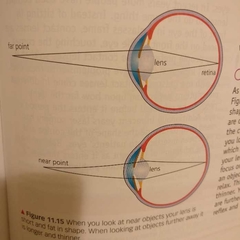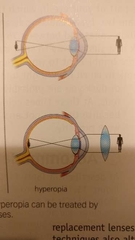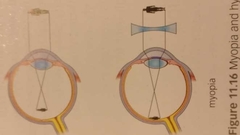![]()
![]()
![]()
Use LEFT and RIGHT arrow keys to navigate between flashcards;
Use UP and DOWN arrow keys to flip the card;
H to show hint;
A reads text to speech;
23 Cards in this Set
- Front
- Back
|
The Eye |
Is the organ of vision |
|
|
How does it detect light? |
Allows animals to detect light and convert into electrical impulses transferred along nerves |
|
|
Structure of Eye |

|
|
|
Iris |
Coloured muscles that surrounds your pupil Controls size of the pupil (contracting and relaxing) to let more or less light in |
|
|
Retina |
Layer of receptors inside your eye Two types of light sensitive cell called RODS or CONES |
|
|
Cornea |
Transparent part of your eye that covers iris and pupil and refracts light through pupil |
|
|
Lens |
Biconvex structure behind your pupil that further refracts light to be focused on your retina, changed in ACCOMODATION |
|
|
Ciliary Body |
Structure made of ciliary muscles and can contract and relax to change the shape of your lens during accomodation |
|
|
Choroid |
Layer of eye between retina and sclera provides oxygen and nourishment to the cells of the retina |
|
|
Fovea |
Specific part of the retina responsible for your sharpest vision. Half of the neurones that leave your eye come from this point |
|
|
Sclera |
The white of your eye, outer layer and protects the rest of your eye |
|
|
Optic Nerve |
Made from neurones that connect your eye to your brain. Electrical impulses from eyes to brain to let you see |
|
|
Cones : Rods |
7 million : 75-150 million |
|
|
Cones |
Require bright light to work properly and allow us to see in colour |
|
|
Rods |
Work in low light intensity, colours are less vivid |
|
|
Accommodation Diagram |

|
|
|
Accomodation |
Lense in your eye can change shape and allow you to focus on objects |
|
|
Accommodation : Near Objects |
Muscles contract which makes lens more convex. Lenses become shorter and fatter so you can focus |
|
|
Accommodation: further away objects |
Ciliary muscles relax and lenses become longer and thinner |
|
|
Hyperopia |
Long - sightedness Unable to correctly focus light on their retina and can not see objects close Eyeball is too short so cornea not curved enough and lens not thick enough |
|
|
Hyperopia Diagrma |

|
|
|
Myopia |
Short sightedness Cant see objects far from you |
|
|
Myopia Diagram |

|

